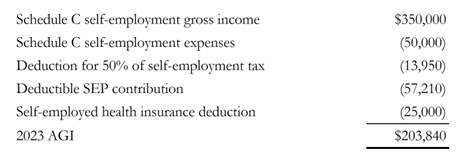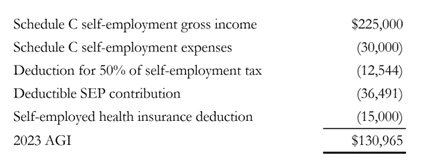December 20, 2022
 Many self-employed individuals are eligible to make annual contributions to Roth IRAs, despite having healthy earnings from their businesses. But some haven’t yet taken advantage of this retirement saving strategy. Making annual Roth contributions can have a big upside by allowing you to accumulate a federal-income-tax-free nest egg for retirement.
Many self-employed individuals are eligible to make annual contributions to Roth IRAs, despite having healthy earnings from their businesses. But some haven’t yet taken advantage of this retirement saving strategy. Making annual Roth contributions can have a big upside by allowing you to accumulate a federal-income-tax-free nest egg for retirement.
Roth IRA Basics
Contributions to Roth IRAs are made with after-tax dollars. So, the tax-saving payoff is on the back end. You can withdraw all your Roth account earnings, along with the sum of your annual contributions, federal-income-tax-free after age 59½, if you’ve had at least one Roth IRA open for over five years. Roth IRA withdrawals that pass these tests are called qualified distributions. However, there are income-based limits on annual Roth contributions.
There are two common misconceptions that successful self-employed people often have about making annual contributions to Roth IRAs:
- I make too much money to qualify for annual Roth contributions.
- Even if I qualify, Roth contributions don’t seem that attractive, because I’m currently in a higher federal income tax bracket than I expect to be during retirement. So I should just focus on making deductible contributions to a traditional tax-deferred retirement arrangement, such as a simplified employee pension (SEP), a solo 401(k) plan or a traditional IRA.
Here’s why these beliefs may be wrong — and why you might want to revise your current retirement-savings plan to include annual Roth contributions.
The Truth about Income Restrictions
Many self-employed individuals with healthy earnings are still eligible to make annual Roth IRA contributions. Rather than giving you a bunch of technical tax lingo, consider this hypothetical example: Jack is a married sole proprietor who files jointly with his nonworking spouse, Jill. They’re 44 and 40 years old, respectively.
For 2023, the couple’s expected joint adjusted gross income (AGI) is $203,840, consisting of the following components:
Their maximum deductible SEP contribution is 20% of their self-employment income net of self-employment expenses and the 50% deduction for self-employment tax [($350,000 minus $50,000 minus $13,950) times 20%]. The couple’s 2023 modified adjusted gross income (MAGI) for purposes of determining eligibility for annual contributions to both Roth IRAs and traditional deductible IRAs is also $203,840.
For 2023, the MAGI phase-out range for Roth IRA contributions by a married joint-filing couple is between $218,000 and $228,000. Therefore, despite their healthy income, Jack and Jill are both eligible to contribute up to $6,500 to their respective Roth IRAs for the 2023 tax year, for a combined total of up to $13,000. Jill’s contribution would be to a spousal Roth IRA based on Jack’s earned income.
There’s often no downside to sole proprietors making Roth IRA contributions. In the hypothetical example, Jack can’t contribute any more to the SEP, and he can’t make a deductible traditional IRA contribution. That’s because the couple’s joint MAGI is well above the ceiling of the 2023 traditional IRA deduction phase-out range of between $116,000 and $136,000 for a joint-filer who participates in a tax-favored retirement plan.
As mentioned earlier, Jill can contribute up to $6,500 to a spousal Roth IRA. She also has the option of contributing up to $6,500 to a traditional deductible spousal IRA — because the couple’s joint MAGI is below the applicable 2023 traditional IRA deduction phase-out range of between $218,000 and $228,000 for a joint-filer who doesn’t participate in a tax-favored retirement plan.
Assuming Jack and Jill have enough cash on hand, making a Roth IRA contribution for Jack is a tax-smart move. Jill can contribute to a spousal Roth IRA if more value is put on earning future federal-income-tax-free income. Or she can contribute to a traditional deductible spousal IRA if more value is put on gaining a current write-off for the contribution.
A similar situation — with a lower income threshold — holds true for self-employed single taxpayers. For example, Jo is a 42-year-old sole proprietor who files as a single taxpayer. Her expected 2023 AGI is $130,965, consisting of the following components:
Jo’s maximum deductible SEP contribution is 20% of her self-employment income net of self-employment expenses and the 50% deduction for self-employment tax [($225,000 minus $30,000 minus $12,544) times 20%]. Her 2023 MAGI for purposes of determining eligibility for annual contributions to both Roth IRAs and traditional deductible IRAs is also $130,965.
For 2023, the Roth IRA contribution MAGI phase-out range is between $138,000 and $153,000 for single filers. Therefore, despite her healthy income, Jo is eligible to contribute up to $6,500 to a Roth IRA for the 2023 tax year.
There’s no downside to making a Roth IRA contribution. Jo can’t contribute any more to her SEP, and she can’t make a deductible traditional IRA contribution. That’s because her MAGI is above the ceiling of the 2023 traditional IRA deduction phase-out range of between $73,000 and $83,000 for a single filer. So assuming Jo has enough cash on hand, making a Roth contribution is a tax-smart move.
Important: If you’re eligible and will be age 50 or older as of December 31, 2023, you can contribute up to an additional $1,000 to a Roth or traditional IRA under the rules for “catch-up” contributions. The same is true for spousal contributions if your spouse is eligible and age 50 or older.
Deductible vs. Nondeductible
There’s a “quick-and-dirty” way to look at the issue of making a deductible contribution to a tax-deferred retirement plan (such as a SEP, solo 401(k) plan or traditional deductible IRA) versus a nondeductible Roth IRA contribution. If you expect to be in a lower tax bracket during retirement, it might be better to make deductible contributions to a traditional tax-deferred arrangement than to make nondeductible contributions to a Roth IRA. But the presumption that you’ll pay lower tax rates during retirement is arguable when you consider the enormous federal debt and huge looming outlays for Social Security and Medicare benefits. If it turns out you pay higher rates in the future, failure to take advantage of Roth contribution opportunities may be cause for regret.
Also remember that if you’ve maxed out on deductible contributions to tax-deferred retirement arrangements, you may not have any opportunities for additional deductible retirement account contributions. In this situation, only your spouse (if you have one) may be eligible for any additional deductible contributions.
The bottom line is that, while contributing the maximum amount to a tax-deferred retirement account may be a good idea, you should also consider contributing to a Roth IRA, if you’re eligible.
GRF Can Help
Don’t overlook the tax benefits of contributing to a Roth IRA. If you’re self-employed, contact your tax advisor to determine if you’re eligible to use this tax-saving retirement planning tool, or reach out to us at the contact info below.

Senior Manager, Tax
Email
Troy Turner, CPA
Vice President and Director of Tax
Email
© 2022


